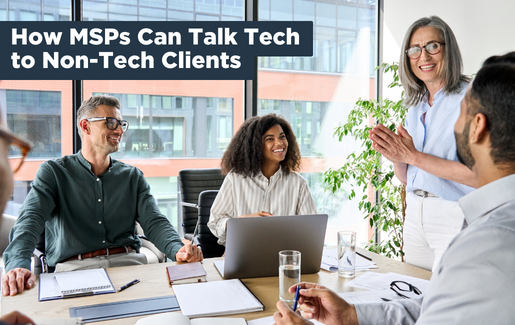 MSPs are often hired to handle technical issues when a business lacks the necessary staff or doesn’t have the knowledge required to manage their technology environment. But despite filling a critical need, MSPs often have difficulty discussing technology with their clients. Wayne Selk, vice president, cybersecurity programs, at CompTIA and executive director of the CompTIA ISAO, has spent a great deal of time helping MSPs and observes that technology conversations between MSPs and clients often go astray.
MSPs are often hired to handle technical issues when a business lacks the necessary staff or doesn’t have the knowledge required to manage their technology environment. But despite filling a critical need, MSPs often have difficulty discussing technology with their clients. Wayne Selk, vice president, cybersecurity programs, at CompTIA and executive director of the CompTIA ISAO, has spent a great deal of time helping MSPs and observes that technology conversations between MSPs and clients often go astray.
There are means to have more effective conversations that can build long-term relationships, said Selk. First suggestion? Maybe not talk about tech in the first place.
“Stop selling technology, you’re only handicapping yourself. Technology changes so quickly. As soon as you convince them they need a certain technology, it will be time for the next thing,” Selk said. “They don’t understand or even care about the technology. Talk instead about what you’re doing for them.”
Starting the Conversation
Initial conversations help to set the tone for your entire relationship. There are ways to put your client at ease from the outset.
Start with a Common Pain Point
As an MSP, you also have technology struggles and it can help your client to know that their struggles are yours too. “There’s often a disconnect between MSPs and their clients,” said Selk. “My suggestion for MSPs is to find some common ground with their client.” Initiate the conversation by sharing those pain points to frame the conversation around shared struggles. This helps clients see technology as operational and develop a connection with MSPs.
Use Business Terminology, Not Jargon
Stakeholders don’t speak tech, they speak business (as well they should). “You want your client to see things from a technology perspective, but they care about the business perspective,” Selk said. “Keep it focused on what they care about.” Try to avoid technology buzz words or language that can only be grasped by technologists because you aren’t speaking to one. Use simple, straightforward language.
Talk About More Than Money
Not everything boils down to cost. Most people go into business because they are passionate about what they’re doing. Discuss risks and what role technology plays in their business. “Part of the disconnect that happens is that MSPs don’t understand their client’s business or objectives,” said Selk. “Once you understand those, you can have a more effective conversation.” There is much more to business goals than money. Talking about how you can help improve a business, based on its goals and objectives, goes a long way.
Leave Them Feeling Positive About the Future
While you do want to include cautionary advice to help reduce their risk, it’s important to make sure that isn’t all you discuss. Ultimately, you want to leave the conversation on a positive note and encourage an optimistic perspective of the future. “Define what’s critical from a cyber perspective and then move on. We all face risk eventually,” said Selk. There doesn’t have to be a doom-and-gloom vibe to protect businesses. Find ways to be positive and forward facing.
Tips for Expanding the Conversation
Once you have developed an initial relationship, you’ll want to ensure you are communicating regularly using the following tips.
Practice Active Listening
Allow your client to lead the conversation and practice active listening. Ask open-ended questions and try to hear the true intent behind your client’s words. Seek to fully understand and hear what your client is saying without expressing judgement or providing immediate responses. Avoid discussing your business or engaging in sales conversations and try to truly clearly grasp your client’s goals
Listen to Their Fears, Worries and Risks
As a technologist, you’re going to bring a unique perspective. Before offering yours, take the time to hear and understand what your client fears. This will help you to better address their concerns and outline a plan of action that benefits your client. As an outside entity, you might believe that you need to provide immediate value and consultation. Ultimately, you’ll be able to supply greater value if you have a better understanding of their concerns.
Avoid FUD (Fear, Uncertainty, Doubt)
Risk is an inevitability in any business. Instilling fear, uncertainty and doubt will only result in unnecessary anxiety and potential panic. Acknowledge that a certain amount of FUD is both normal and healthy, but don’t encourage negativity. Center your conversations around building resilience to risk and you can reduce your client’s apprehension surrounding technology. Also, focus on the areas of highest risk. There’s no need to discuss every possible security scenario. Discuss how your teams would handle situations with the highest impact and then focus on building positive resilience.
Schedule Regular Touchpoints
The only certainty with technology is change. Regular touchpoints allow you to review progress and identify new areas of risk. It also creates an ongoing dialogue with your clients and gives them ample opportunity to ask questions and voice concerns. Some touchpoints may be once per week, others once per month. Determine a schedule that promotes communication but is also a valuable use of everyone’s time.
“If you’ve done your work properly, these conversations are much easier to have with clients,” Selk said.
Want more business resources?
Check out CompTIA’s MSP Marketing Playbook for 90+ pages of best practices and more.

 Add CompTIA to your favorite RSS reader
Add CompTIA to your favorite RSS reader

